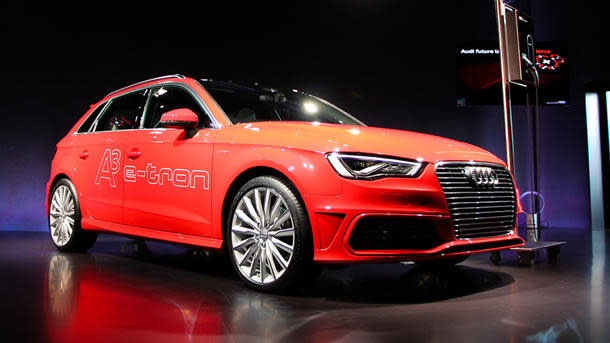 Motoramic
MotoramicAudi readies a plug-in hybrid for America, and a way to time traffic lights
Audi’s motto, “Vorsprung durch Technik,” may not roll off the average American’s tongue, but those are some hallowed words in Audi’s hometown of Ingolstadt. In English, they mean “Truth in Engineering,” and at this year’s Audi Future Lab media program held at Berlin’s famous Templehof airfield, the facility that served West Berlin during the Berlin Airlift, Audi took the opportunity to show us some of the ways it is putting its money where its mantra is.
The rollout focused on four complete, nearly complete or stillborn cars that contained innovative electrification or alternative fueling features, including the sensational but stillborn R8 e-tron supercar (click here for a full report), the A3 e-tron plug-in hybrid, the A3 g-tron gas/CNG bi-fuel vehicle, and a prototype of its glorious, LeMans-winning R-18 e-tron quattro hybrid racecar. Audi also brought along the A1 e-tron, another electrified runabout that won’t see the light of day but which had a working version of Audi’s upcoming traffic light information system that will soon start appearing in other production Audi models.
2014 Audi A3 e-tron
The only car that is certain to make it to American shores is the A3 e-tron, a plug-in gasoline-electric hybrid that functions somewhat like the Chevrolet Volt but looks, well, like the sexy Audi hatchback it is. In fact, Audi was emphatic about how much the A3 e-tron, which is based on the upcoming, all-new 2014 A3 Sportback, does not look like other hybrid or electric cars (only the badges and the chrome-trimmed grille will set it apart from other A3s). Of course, this may be a good thing or a bad thing to eco-minded customers, as some like to blend in, while others brandish their Priuses like green badges of courage.
Due in 2014, the A3 e-tron has a large, 8.8-kWh battery pack, which Audi claims can supply enough juice for about 31 miles of electric driving before the 1.4-liter four-cylinder engine fires up to propel you another 400 miles or so (perhaps 500 if you drive like the European fuel economy testers do). The combined power and torque rating for the two motors is 204 hp and 258 lb-ft of torque, which is very close to the 2013 Audi A3 2.0T four-cylinder’s output.
Functionally, what sets the A3 e-tron apart from the Volt is the way it allows the driver to decide which fuel source it will use and when. With sufficient battery reserves, the default driving mode prioritizes the electric motor, locking the gas motor out until it is summoned by flooring the throttle. The driver can, however, lock the gasoline motor out altogether and drive purely in EV mode, say, in municipal zones with zero-emissions driving mandates (we don’t have many such areas in the U.S., but could soon). Alternatively, the driver can select a mode that locks out the electric motor in case you are approaching one of the aforementioned zero-emissions zones and want to save your battery reserves for that. And the driver may also choose a mode that uses the engine power to aggressively charge the battery in the event that you are nearing such an area with a low battery.
The Volt, by comparison, basically uses electricity to power the car until the battery has reached a low state of charge, at which point its range extender engine turns on to recharge the batteries in real time to keep it moving; the driver has little control over the handoff since the engine does not directly drive the wheels.
Unfortunately, I didn't get to sample the A3 e-tron, but Audi says it can accelerate briskly — about seven and a half seconds to 60 mph. The top electric-only speed is 81 mph, while the overall top speed is 138 mph.
The A3 e-tron (and any plug-in models that will follow) will be offered with a slick black home charging station that will facilitate a high-voltage connection to your home’s power source. Installation of the unit will be arranged by the dealership that sold the car, and Audi of America is contemplating including it with the purchase price.
Like most other plug-ins, Audi also has prepared a sophisticated remote vehicle management system, allowing customers to schedule charging as needed in order to take advantage of off-peak power rates via their home computer or smartphone app. One unique feature is a mode that directs nearly all of the charging to be done at night, but holds off on the last percentage of charging until just before a preset time you expect to get in and drive—say, just before you usually leave for work—with the final minutes of charging pre-warming the battery to its most efficient operating temperature, maximizing its efficiency and range when on the road. Naturally, the app will allow you to brag to your friends and family about exactly how green you’re being via Facebook, Twitter and the like.
Also like other manufacturers, Audi is working on a cordless inductive charging system similar to those used in electric toothbrushes (only car-sized). Audi was not prepared with many details about that other than to stress that its sensors would not allow the system to electrocute Fido or Fifi if either was to take a nap beneath the car. For now, the car will use an actual cord that connects to the car via a port concealed behind the four-ring badge in the grille.
Audi did not provide a price estimate for the A3 e-tron, but we expect it to carry a relatively hefty premium compared to other A3s, especially if it includes the wall charger. The Volt carries a sticker in the $40,000 range, so figure on something well above $50,000 for the A3 e-tron when it arrives sometime in 2014.
Audi A3 g-tron and Audi’s CNG production plant in Germany

 Yahoo Autos
Yahoo Autos 

